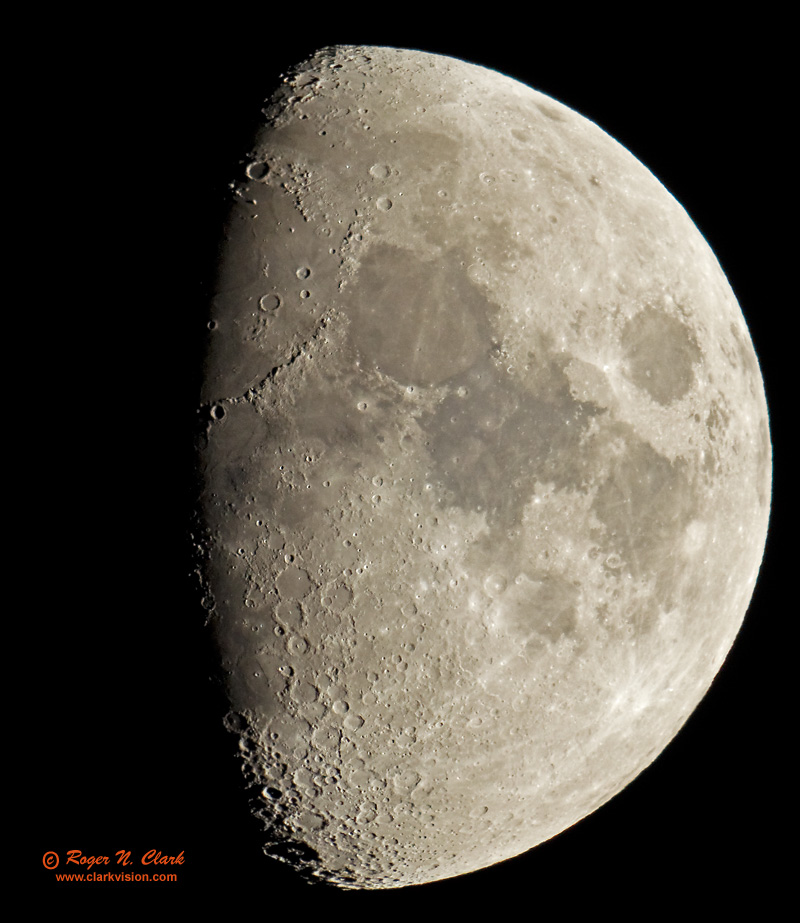| Home | Galleries | Articles | Reviews | Best Gear | New | About | Contact | Gallery Index | Previous |
Next |

| Home | Galleries | Articles | Reviews | Best Gear | New | About | Contact | Gallery Index | Previous |
Next |

The first quarter Moon was low in the sky in July from Colorado, yet this is a very impressive image taken with a telephoto lens on a tripod. The image illustrates several properties. First, it was obtained using stacked 1.4 and 2x teleconverters (TCs). A common misconception is that TCs reduce image quality and stacking TCs is rarely done. Yet this image shows that with quality lenses and quality TCs, sharp images can still be obtained. Note the image above is not full resolution. You can see the full resolution image using the link below.
Second, You see many posts on the internet about equivalent focal length. A small camera with a tiny sensor needs a short focal length lens to give the same field of view as a lens on a 35 mm camera. That has led to the concept of equivalent focal length. The equivalent focal length is the focal length on a camera that gives the same field of view as a given focal length on a 35 mm camera. For example, if the sensor on camera X is 1/4 the linear dimension as a 35 mm frame, then to get the same field of view, one needs a real focal length only 1/4 what would be used on a 35 mm camera. If camera X had a 350 mm focal length lens, then it has the field of view equivalent of a 1400 mm lens on a 35 mm camera. This leads to a common misconception that equivalent focal length means telephoto reach. Note the camera used has a 1.3x crop sensor.
The image here demonstrates what a true 1400 mm focal length lens will deliver in image detail. The image was produced with a Canon 1D Mark IV, 16 megapixel digital camera using a 500 mm f/4 L IS super telephoto lens with stacked 2X and 1.4x TCs. The f/ratio of the system was f/11.2. The 1D Mark 4 camera will autofocus at f/8 and stacked TC only report one, so the camera thought the system was at f/8 and autofocus was used for this image. I used mirror lock up with the camera on a tripod. Exposure was 1/100 second at ISO 400. This is a single frame image. The raw data were converted to a 16-bit tiff interpolated to 25 megapixels. During conversion, chromatic aberration was corrected (amounting to about 1 pixel). The image was then sharpened using Richardson-Lucy image deconvolution using a 5x5 box and 32 iterations. The image was interpolated back to 16 megapixels and a small amount of unsharp mask applied. The plate scale of the full resolution image is 0.84 arc-seconds/pixel. The diffraction spot diameter for green light is 2.1 arc-seconds (2.5 pixels). The image is diffraction limited.
A larger aperture telescope with 1400 mm focal length will deliver higher image quality if the Moon was higher in a steadier sky.
For reference, 1 arc-second is 1/3600 of one degree or about the width of a human hair at a distance of about 50 feet (15.7 meters) (assumed a hair is 0.003 inch in diameter).
The full resolution image (781 Kbytes) can be seen HERE.
To learn how to obtain stunning images like this, please visit my Extensive Articles on Photography .
Keywords to this image = astrophoto-1 moon night canon_1d4
Image ID: moon.c07.19.2010.c45i1027.1400mm.d-923.jpg
| Home | Galleries | Articles | Reviews | Best Gear | Science | New | About | Contact |
Last updated April 02, 2025